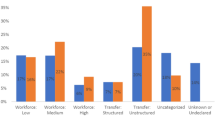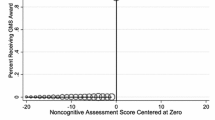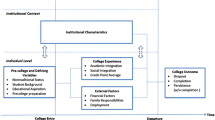Abstract
The study examines the direct and indirect costs of enrolling initially at a community college before transferring to a 4-year institution for baccalaureate-degree-seeking students in the USA. Using nationally generalizable data, this study employs propensity score weighting to identify the influence of initial community college enrollment on baccalaureate degree attainment, cumulative student loan debt, and time-to-degree. Our findings show that students who enrolled initially at a community college before transferring to a 4-year institution were less likely to obtain their baccalaureate degree, accrued $2221 less in cumulative student loan debt, and took about three months longer to graduate than their peers who began at 4-year colleges and universities. We provide empirical evidence of the potential trade-off associated with direct savings in cumulative loan debt and indirect costs of community college enrollment related to decreases in the likelihood of baccalaureate degree attainment and increases in time-to-degree. Given these findings, we suggest that 4-year institutions should alter their institutional policies to better accommodate vertical transfer students and ensure that these historically underrepresented students are able to succeed academically.


Similar content being viewed by others
References
Aina, C. and Casalone, G. (2011) ‘Does time-to-degree matter? The effect of delayed graduation on employment and wages (Working Papers 38)’, AlmaLaurea Inter-University Consortium.
Alfonso, M. (2006) ‘The impact of community college attendance on baccalaureate attainment’, Research in Higher Education 47(8): 873–903.
American Association for Community Colleges (AACC) (2016) ‘2016 fact sheet’. Retrieved from http://www.aacc.nche.edu/AboutCC/Documents/AACCFactSheetsR2.pdf.
Austin, P.C. (2011) ‘An introduction to propensity score methods for reducing the effects of confounding in observational studies’, Multivariate Behavioral Research 46(3): 399–424.
Ayers, D.F. (2002) ‘Mission priorities of community colleges in the southern United States’, Community College Review 30(3): 11–30.
Bailey, T., Jeong, D.W. and Cho, S. (2010) ‘Referral, enrollment, and completion in developmental education sequences in community colleges’, Economics of Education Review 29(2): 255–270.
Bailey, T. and Morest, V.S. (2006) Defending the Community College Equity Agenda, Baltimore, MD: The Johns Hopkins University Press.
Barreno, Y. and Traut, C.A. (2012) ‘Student decisions to attend public two-year community colleges’, Community College Journal of Research and Practice 36(11): 863–871.
Baum, S., Elliott, D.C. and Ma, J. (2014) Trends in student aid 2014, The College Board. Retrieved from https://secure-media.collegeboard.org/digitalServices/misc/trends/2014-trends-student-aid-report-final.pdf.
Baum, S. and Ma, J. (2014) Trends in College Pricing 2014, The College Board. Retrieved from https://secure-media.collegeboard.org/digitalServices/misc/trends/2014-trends-college-pricing-report-final.pdf.
Belfield, C.R. and Bailey, T. (2011) ‘The benefits of attending community college: A review of the evidence’, Community College Review 39(1): 46–68.
Bound, J., Lovenheim, M.F. and Turner, S. (2012) ‘Increasing time to baccalaureate degree in the United States’, Education Finance and Policy 7(4): 375–424.
Caliendo, M. and Kopeinig, S. (2008) ‘Some practical guidance for the implementation of Propensity Score Matching’, Journal of Economic Surveys 22(1): 31–72.
Carnevale, A.P., Rose, S.J. and Cheah, B. (2011) The College Payoff: Education, Occupation, Lifetime Earnings, Washington, D.C.: The Georgetown University Center on Education and the Workforce.
Cohen, A.M., Brawer, F.B. and Kisker, C.B. (2014) The American Community College (6th ed), San Francisco, CA: Jossey-Bass
Dietrich, C.C. and Lichtenberger, E.J. (2015) ‘Using propensity score matching to test the community college penalty assumption’, The Review of Higher Education 38(2): 193–219.
Dougherty, K.J. (1992) ‘Community colleges and baccalaureate attainment’, The Journal of Higher Education 63(2): 188–214.
Dougherty, K.J. (1994) The Contradictory College, Albany, NY: State University of New York Press.
Doyle, W.R. (2009) ‘The effect of community college enrollment on bachelor’s degree completion’, Economics of Education Review 28(2): 199–206.
DuGoff, E.H., Schuler, M. and Stuart, E.A. (2014) ‘Generalizing observational study results: Applying propensity score methods to complex surveys’, Health Services Research 49: 284–303.
Ehrenberg, R.G. and Smith, C.L. (2004) ‘Analyzing the success of student transitions from 2- to 4-year institutions within a state’, Economics of Education Review 23(1): 11–28.
Fonte, R. (2011) ‘The community college alternative’, Academic Questions 24(4): 419–428.
Goldhaber, D. and Peri, G.K. (2007) ‘Community colleges’, in S. Dickert-Conlin and R. Rubenstein (eds.) Economic Inequality and Higher Education: Access, Persistence, and Success, New York, NY: The Russell Sage Foundation, pp. 101–127.
Goldrick-Rab, S. (2010) ‘Challenges and opportunities for improving community college student success’, Review of Educational Research 80(3): 437–469.
Gonzalez, A. and Hilmer, M.J. (2006) ‘The role of 2-year colleges in the improving situation of Hispanic postsecondary education’, Economics of Education Review 25(3): 249–257.
Gonzalez Canche, M.S. (2014) ‘Is the community college a less expensive path toward a bachelor’s degree? Public 2- and 4-year colleges’ impact on loan debt’, The Journal of Higher Education 85(5): 723–759.
Grimes, S.K. and David, K.C. (1999) ‘Underprepared community college students: Implications of attitudinal and experiential differences’, Community College Review 27(2): 73–92.
Grites, T.J. (2004) ‘Redefining the role: Reflections and directions’ in T. J. Kerr, M. C. King and T. J. Grites (eds.) Advising Transfer Students: Issues and Strategies, Seattle, WA: NACADA, National Academic Advising Association Monograph Series, No. 12, pp. 123–132.
Guo, S. and Fraser, M. (2015) Propensity Score Analysis (2nd ed), Thousand Oaks, CA: SAGE.
Handel, S.J. (2013) ‘Community college students earning the baccalaureate degree: The good news could be better’, College and University 89(2): 22–30.
Hilmer, M.J. (1997) ‘Does community college attendance provide a strategic path to quality education?’, Economics of Education Review 16(1): 59–68.
Ishitani, T.T. and McKitrick, S.A. (2010) ‘After transfer: The engagement of community college students at a four-year collegiate institution’, Community College Journal of Research and Practice 34(7): 576–594.
Jaeger, D. and Page, M. (1996) ‘Degrees matter: New evidence on sheepskin effects in the returns to education’, The Review of Economics and Statistics 78(4): 733–740.
Jenkins, D. and Fink, J. (2016) Tracking transfer: New measures of institutional and state effectiveness in helping community college students attain bachelor’s degrees, Community College Research Center. Retrieved from http://ccrc.tc.columbia.edu/media/k2/attachments/tracking-transfer-institutional-state-effectiveness.pdf
Kahlenberg, R.D. (2004) America’s Untapped Resource: Low-Income Students in Higher Education, New York, NY: Century Foundation Press.
Kane, T.J. and Rouse, C.E. (1999) ‘The community college: Educating students at the margin between college and work’, The Journal of Economic Perspectives 13(1): 63–84.
Kienzl, G.S., Wesaw, A.J. and Kumar, A. (2012) Understanding the Transfer Process: A Report by the Institute for Higher Education Policy for the Initiative on Transfer Policy and Practice. Washington, D.C.: Institute for Higher Education Policy.
Kurlaende, M., Jackson, J., Howell, J.S. and Grodsky, E. (2014) ‘College course scarcity and time to degree’, Economics of Education Review 41(1): 24–39.
Levin, J.S. (2000) ‘The revised institution: The community college mission at the end of the Twentieth Century’, Community College Review 28(2): 1–25.
Long, B.T. and Kurlaender, M. (2009) ‘Do community colleges provide a viable pathway to a baccalaureate degree?’, Educational Evaluation and Policy Analysis 31(1): 30–53.
Mankiw, N.G. (1998) Principles of Microeconomics, Fort Worth, TX: The Dryden Press.
McKinney, L. and Burridge, A.B. (2015) ‘Heling or hindering? The effects of loans on community college student persistence’, Research in Higher Education 56(4): 299–324.
McKinney, L., Mukherjee, M., Wade, J., Shefman, P. and Breed, R. (2015) ‘Community college students’ assessments of the costs and benefits of borrowing to finance higher education’, Community College Review 43(3): 329–354.
Melguizo, T. (2009) ‘Are community colleges an alternative path for Hispanic students to attain a bachelor’s degree?’, Teachers College Record 111(1): 90–123.
Melguizo, T. and Dowd, A.C. (2009) ‘Baccalaureate success of transfers and rising 4-year college juniors’, Teachers College Record 111(1): 55–89.
Melguizo, T., Kienzl, G.S. and Alfonso, M. (2011) ‘Comparing the educational attainment of community college transfer students and four-year college rising juniors using propensity score matching methods’, The Journal of Higher Education 82(3): 265–291.
Monaghan, D.B. and Attewell, P. (2015) ‘The community college route to the bachelor’s degree’, Educational Evaluation and Policy Analysis 37(1): 70–91.
Monk-Turner, E. (1995) ‘Factors shaping the probability of community vs. four-year college entrance and acquisition of the B.A. degree’, The Social Science Journal 32(3): 255–264.
Mooring, R.D. and Mooring, S.R. (2016) ‘Predictors of timely baccalaureate attainment for underrepresented minority community college transfer students’, Community College Journal of Research and Practice 40(8): 681–694.
Prager, C. (2001) ‘Accrediting for curricular coherence’, in H. Rafael (ed.) General Education in An Age of Student Mobility, Washington, DC: Association of American Colleges and Universities, pp. 26–29.
Provasnik, S. and Planty, M. (2008) Community colleges: Special supplement to the condition of education 2008 (NCES 2008-033), National Center for Education Statistics, Institute of Education Sciences, U.S. Department of Education. Washington, D.C.
Reynolds, C.L. (2012) ‘Where to attend? Estimating the effects of beginning college at a two-year institution’, Economics of Education Review 31(4): 345–362.
Reynolds, C.L. and DesJardins, S.L. (2009) ‘The use of matching methods in higher education research: Answering whether attendance at a 2-year institution results in differences in educational attainment’, in J.C. Smith (ed.) Higher Education: Handbook of Theory and Research, New York: Springer, pp. 47–97.
Roberts, J. and McNeese, M.N. (2010) ‘Student involvement/engagement in higher education based on student origin’, Research in Higher Education Journal 7(1): 1–11.
Rosenbaum, P.R. (2002) Observational Studies, New York, NY: Springer-Verlag.
Rosenbaum, P.R. and Rubin, D.B. (1983) ‘The central role of the propensity score in observational studies for causal effects’, Biometrika 70(1): 41–55.
Rouse, C.E. (1995) ‘Democratization or diversion? The effect of community colleges on educational attainment’, Journal of Business and Economic Statistics 13(2): 217–224.
Rubin, D.B. (1997) ‘Estimating causal effects from large data sets using propensity scores’, Annals of Internal Medicine 127(8): 757–763.
Schudde, L.T. (2011) ‘The causal effect of campus residency on college student retention’, The Review of Higher Education 34(4): 581–610.
Shadish, W.R., Cook, T.D. and Campbell, D.T. (2002) Experimental and Quasi-Experimental Designs for Generalized Causal Inference, Boston: Houghton Mifflin.
Shannon, H.D. and Smith, R.C. (2006) ‘A case for the community college’s open access mission’, New Directions for Community Colleges 136: 15–21.
Somers, P., Haines, K., Keene, B., Bauer, J., Pfeiffer, M., McCluskey, J., Settle, J. and Sparks, B. (2006) ‘Towards a theory of choice for community college students’, Community College Journal of Research and Practice 30(1): 53–67.
Stokes, T. and Somers, P. (2009) ‘Who enrolls in two-year colleges? A national study of price response’, Journal of Student Financial Aid 39(1): 4–18.
Townsend, B.K. and Wilson, K.B. (2006) ‘“A hand hold for a little bit”: Factors facilitating the success of community college transfer students to a large research university’, Journal of College Student Development 47: 439–456.
U.S. Department of Education. (2016) Beginning Postsecondary Students, Retrieved from https://nces.ed.gov/surveys/bps/about.asp.
Wood, J.L. and Harrison, J.D. (2014) ‘College choice for black males in the community college: Factors influencing institutional selection’, The Negro Educational Review 65(1–4): 87–97.
Xu, D., Jaggars, S.S. and Fletcher, J. (2016) ‘How and why does two-year college entry influence baccalaureate aspirants’ academic and labor market outcomes? (A CAPSEE Working Paper)’. Retrieved from Community College Research Center website: http://ccrc.tc.columbia.edu/publications/capsee-how-and-why-two-year-college-entry-influence-outcomes.html.
Author information
Authors and Affiliations
Corresponding author
Rights and permissions
About this article
Cite this article
Hu, X., Ortagus, J.C. & Kramer, D.A. The Community College Pathway: An Analysis of the Costs Associated with Enrolling Initially at a Community College Before Transferring to a 4-Year Institution. High Educ Policy 31, 359–380 (2018). https://doi.org/10.1057/s41307-017-0063-7
Published:
Issue Date:
DOI: https://doi.org/10.1057/s41307-017-0063-7




